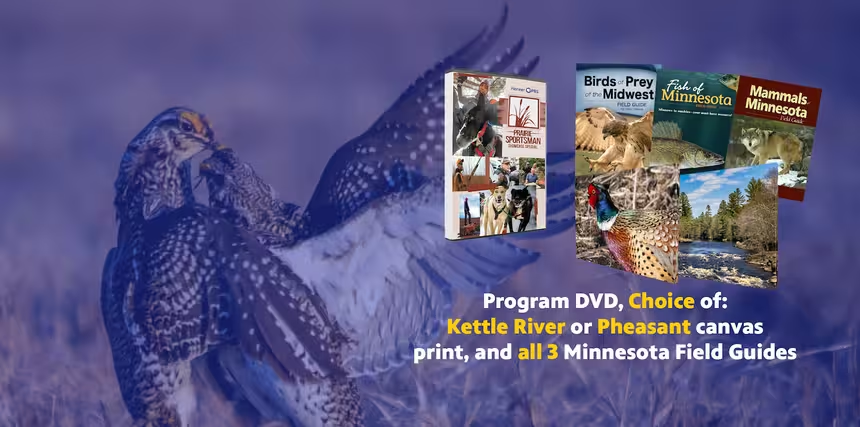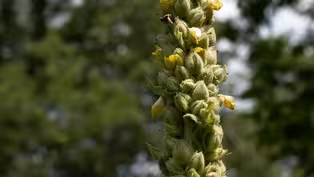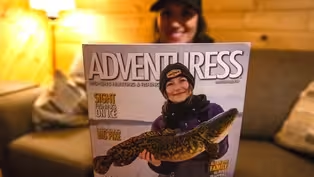Prairie Sportsman
A Superior Threat
Clip: Season 16 Episode 8 | 8m 12sVideo has Closed Captions
Researchers study cyanobacteria threats to Lake Superior.
Researchers study the evolutionary significance of cyanobacteria, more commonly called blue-green algae, as the organism is beginning to appear in the cold waters of Lake Superior. Understanding these algae blooms are key to predicting when the toxic version of cyanobacteria might appear and pose threats to people and pets.
Problems playing video? | Closed Captioning Feedback
Problems playing video? | Closed Captioning Feedback
Prairie Sportsman is a local public television program presented by Pioneer PBS
Production sponsorship is provided by funding from the Environment and Natural Resources Trust Fund, West Central Initiative, Shalom Hill Farm, and members of Pioneer PBS.
Prairie Sportsman
A Superior Threat
Clip: Season 16 Episode 8 | 8m 12sVideo has Closed Captions
Researchers study the evolutionary significance of cyanobacteria, more commonly called blue-green algae, as the organism is beginning to appear in the cold waters of Lake Superior. Understanding these algae blooms are key to predicting when the toxic version of cyanobacteria might appear and pose threats to people and pets.
Problems playing video? | Closed Captioning Feedback
How to Watch Prairie Sportsman
Prairie Sportsman is available to stream on pbs.org and the free PBS App, available on iPhone, Apple TV, Android TV, Android smartphones, Amazon Fire TV, Amazon Fire Tablet, Roku, Samsung Smart TV, and Vizio.

Prairie Sportsman Premium Gifts
Do you love the great outdoors, hunting, fishing, hiking and conservation? Consider becoming a friend of Prairie Sportsman to support it and receive gifts with your contribution.Providing Support for PBS.org
Learn Moreabout PBS online sponsorship(upbeat music) - [Bret] This scene is way too familiar.
Signs warning us of the dangers in our lakes, rivers, and streams.
Many cases, these dangers are created by cyanobacteria, more commonly called blue-green algae.
While these algae blooms prefer warmer and shallower water, recently they've been showing up in our Great Lakes, including the coldest and deepest Lake Superior.
(gentle acoustic music) - Like other algae that we have, cyanobacteria is an organism that can undergo photosynthesis so it can produce its own food from sunlight, but cyanobacteria can also produce toxins, which is why we care about it from a public health standpoint.
- We think about cyanobacteria in the history of earth, these organisms have been around for billions of years.
So they've seen conditions where we had no oxygen, they saw dinosaurs, these things saw meteors coming down, yet they still survive, right?
And so part of when we have these big blooms, it's not so much that we can come in and just like knock them out clean.
It's how we also think about like managing them.
- We still don't fully understand why they produce toxins or what events trigger them to produce toxins and that's what we're trying to better understand.
So this project, we're actually just starting this year.
It's a project that was funded by NOAA through the Minnesota Sea Grant College Program.
Really what we want to do is take a molecular approach Really what we want to do is take a molecular approach to understanding these organisms.
- The interesting thing about cyanotoxins is that there's several types.
The one that we're most frequently encountering here in Minnesota is microcystin, and there are over 150 different styles of these.
These are really big compounds built out of amino acids, and the way they arrange them make them more toxic or less toxic.
Part of what we're trying to understand is not just like who has these genes, but also kind of why they're making these.
Are these storage compounds that have just been co-opted for other things over time, or do they have some sort of functional role that is just evolutionary significant?
(gentle acoustic music) - Not all cyanobacteria produce toxins.
So cyanobacteria are good, they provide food for things upper in the food chain like the fish that we like to eat.
But every once in a while, you get these nuisance strains that cause stress to that ecosystem and those are the ones that we're really trying to understand from a public health perspective.
- When you look out here at Lake Superior, the water clarity is so great and it's cold too.
These types of lakes around the world are very atypical for blooms.
- In Lake Superior, really the first reported bloom in recent memory was around 2018.
We saw bloom along the south shore of Lake Superior, and we're starting to see them also in the St. Louis River Estuary.
One of the important distinction is the strain that we find in Lake Superior isn't able to produce toxins, but the organisms that we do find in the St. Louis River Estuary do have those genes present.
Now that we're starting to see them, there's something in the lake that's changing.
We think that's largely related to climate change, but we're still trying to figure that out.
- When you start looking at all the data, it starts to point to say, maybe there's something greater happening here.
Specifically in Lake Superior, we've been trying to think about their natural lifecycle, like are these organisms being invaded?
Like are they coming in from other places and just growing really quickly or are these actually just part of the natural ecosystem?
And something about the lake changing is really what's driving their growth now.
- The ultimate overall goal of this project, the big question we had coming into it that seed grant wanted answered, under what conditions would a toxic cyanobacterial bloom form in Lake Superior?
So right now we're trying to understand a little bit more about the fundamental ecology of the organism, basically what causes it to grow and then learn a little more about what the environmental triggers are that cause it to release toxins into the environment that are harmful to people and pets.
- Once we have that, we can start thinking more broadly, not just about Lake Superior, but how these organisms are connected to say Lake Michigan, Erie or the same organism or a flavor of this organism that causes these blooms is also found.
- [Chris] If we can understand those systems a little better, we can better forecast where these .. are going to occur so we can get out some early warnings.
- Understanding when it starts to come up naturally in its lifecycle is the key.
And when we start thinking about it's coming up on its natural growth cycle, when does it produce that toxin?
Once we kind of figure that out, it's like, okay, how do we deal with their sort of lifestyle on top of like things that we want to do, like fishing and boating and things like that.
(upbeat acoustic music) - I think when most people think about cyanobacteria or like poor water quality, for the Great Lakes, people probably think about Lake Erie,.. We know Lake Erie has these annual cyanobacteria blooms.
In 2014, the bloom was so bad and toxic that those toxins got into the Toledo water supply and shut down drinking water for almost a week.
So these are the things we're really keen to understand more about.
We're also going to do some experimental trials under like future climate scenarios to see how different strains compete with each other.
And the thing we're really trying to track is whether or not this is like an early warning sign that the lakes are changing.
- Part of the work that we're doing in the lab right now is really thinking about future conditions and how these organisms will respond under elevated CO2 concentrations, which we keep seeing going up and up and up and also elevated temperatures.
- Although it's not a problem now, this is something we want to get out in front of because once it's here, it's already too late.
And I think we just want to be cognizant of that problem just to keep people safe as best we can.
- As scientists, you know, we don't get to be the stewards, right?
But we get to help them inform people who are in that mindset of like being stewards of the land or stewards of the water.
And you know, if we can help inform that and help sort of guide these hands, maybe we'll have a good resource for the next 100 years.
- [Narrator] Stories about aquatic invasive species researc are brought to you by the Aquatic Invasive Species Task Forces of Meeker, Yellow Medicine, Lac Qui Parle, Swift and Big Stone counties, and by the Environment and Natural Resources Trust Fund.
We can stop aquatic hitchhikers from infesting more lakes and streams by cleaning up everything we pull out of the water.
It's a simple drill.
Clean in, clean out.
Before leaving a water access, clean your boat and water equipment, remove and dispose of all plants and aquatic species in the trash, drain water from your boat, ballast tanks, motor, live well and bait container, remove drain plugs and keep drain plugs out while transporting equipment, Dispose of unwanted bait in the trash.
To keep live bait, drain the water and refill the bait container with bottled or tap water.
And if you have been in infested waters, also spray your boat with high pressure water.
Rinse with very hot water, dry for at least five days.
Stop the spread of AIS.
Video has Closed Captions
Clip: S16 Ep8 | 2m 26s | Fast Forager Nicole Zempel introduces us to the medicinal power of mullein. (2m 26s)
Women Adventurers and Lake Superior Threats
Preview: S16 Ep8 | 30s | Visit with Adventuress Magazine’s Jennifer Pudenz, and researchers study cyanobacteria threats. (30s)
Video has Closed Captions
Clip: S16 Ep8 | 14m 48s | Jennifer Pudenz of Adventuress Magazine takes her first trip to the Northwest Angle. (14m 48s)
Providing Support for PBS.org
Learn Moreabout PBS online sponsorship
- Science and Nature

Explore scientific discoveries on television's most acclaimed science documentary series.

- Science and Nature

Capturing the splendor of the natural world, from the African plains to the Antarctic ice.












Support for PBS provided by:
Prairie Sportsman is a local public television program presented by Pioneer PBS
Production sponsorship is provided by funding from the Environment and Natural Resources Trust Fund, West Central Initiative, Shalom Hill Farm, and members of Pioneer PBS.




